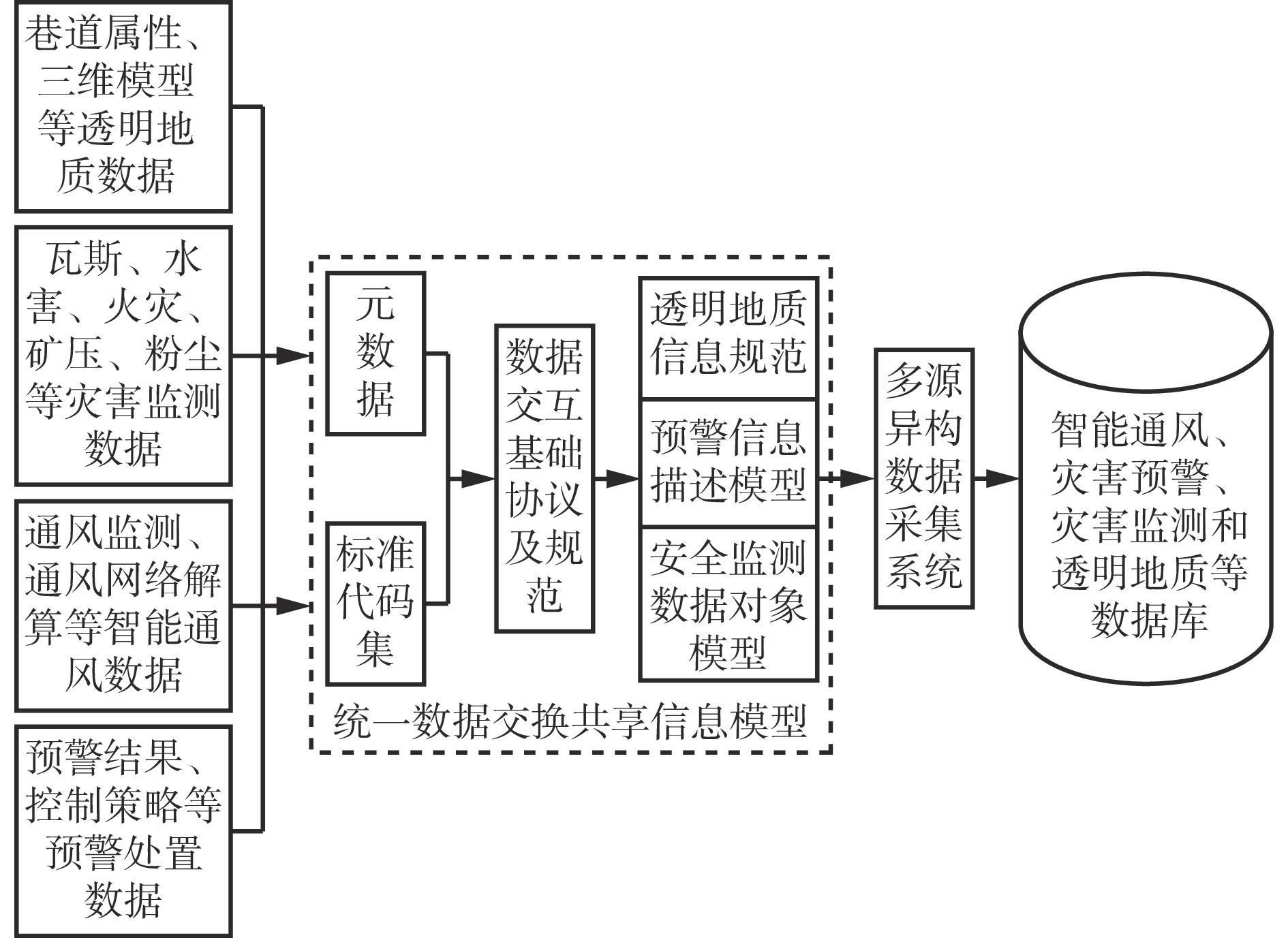Coal mine disaster integration management and control platform based on unified digital base
-
摘要:
针对煤矿灾害监测预警与透明地质系统数据多源异构、预警结果可视化手段单一、业务流程不畅、数字化决策支撑不足等问题,提出了基于统一数字底座的煤矿灾害融合管控平台。该平台分为数据采集层、数据存储层、应用支撑层和应用层,以透明地质系统为井巷工程数据来源,利用智能通风系统进行通风网络解算和通风决策分析,集成各灾害预警系统分析结果和控制策略,从空间和业务2条主线按照“隐蔽致灾因素—安全监测—安全管理—灾害预警—仿真规划—协同控制”进行灾害全链路管控。该平台利用Web API和FIP接口对透明地质系统数据与服务进行集成,基于统一的预警信息描述规范对灾害预警数据进行集成,通过“场景—模型—对象—属性”层级结构的数据对象模型对安全监测数据进行集成,解决了数据一致性难题;从巷道拓扑关系生成、巷道三维模型生成和要素空间关系生成等方面进行井巷工程三维参数化建模,实现了基于透明地质系统数据的井巷工程自动更新;采用“模型压缩+浏览器端缓存+渲染调度策略优化”,实现了基于WebGL的地质体三维可视化;通过逐级确认的预警事件协同处置机制,提升了预警结果及处置的可靠性。现场应用结果表明,该平台实现了基于统一数字底座的瓦斯、水害、火灾、矿压、粉尘、智能通风等系统数据同步、功能集成、流程衔接和统一可视化,为开展融合透明地质的灾害预警提供了支撑。
Abstract:In response to the challenges of multi-source heterogeneous data from coal mine disaster monitoring and early warning systems, limited visualization methods for early warning results, inefficient business processes, and insufficient digital decision support, a coal mine disaster integration control platform based on a unified digital base is proposed. This platform consists of a data acquisition layer, data storage layer, application support layer, and application layer. The transparent geological system serves as the data source for shaft and tunnel engineering, utilizing an intelligent ventilation system for ventilation network calculations and ventilation decision analysis. The platform integrates the analysis results and control strategies of various disaster warning systems, conducting full-chain disaster control along two main lines: spatial and business, following the process of "concealed disaster-causing factors—safety monitoring—safety management—disaster early warning—simulation planning—coordinated control." The platform integrates the transparent geological system's data and services through Web API and FIP interfaces, and integrates disaster early warning data based on a unified early warning information description standard. Safety monitoring data is integrated using a hierarchical data object model based on the "scene—model—object—attribute" structure, addressing the issue of data consistency. It also conducts three-dimensional parametric modeling of shaft and tunnel engineering from aspects such as tunnel topology generation, tunnel 3D model creation, and spatial element relationship generation, enabling automatic updates of shaft and tunnel engineering based on transparent geological system data. The platform employs "model compression + browser-side caching + rendering scheduling optimization" to achieve 3D visualization of geological bodies based on WebGL. Through a step-by-step confirmation mechanism for coordinated handling of early warning events, the reliability of warning results and responses is enhanced. Field application results show that the platform achieves synchronization of data from gas, water, fire, mining pressure, dust, intelligent ventilation, and other systems, functional integration, process coordination, and unified visualization, providing support for disaster early warning using integrated with transparent geology.
-
-
-
[1] 刘峰,曹文君,张建明,等. 我国煤炭工业科技创新进展及“十四五”发展方向[J]. 煤炭学报,2021,46(1):1-15. LIU Feng,CAO Wenjun,ZHANG Jianming,et al. Current technological innovation and development direction of the 14th Five-Year Plan period in China coal industry[J]. Journal of China Coal Society,2021,46(1):1-15.
[2] 刘峰,曹文君,张建明. 持续推进煤矿智能化 促进我国煤炭工业高质量发展[J]. 中国煤炭,2019,45(12):32-36. DOI: 10.3969/j.issn.1006-530X.2019.12.006 LIU Feng,CAO Wenjun,ZHANG Jianming. Continuously promoting the coal mine intellectualization and the high-quality development of China's coal industry[J]. China Coal,2019,45(12):32-36. DOI: 10.3969/j.issn.1006-530X.2019.12.006
[3] 王国法. 《煤矿智能化建设指南(2021年版)》解读——从编写组视角进行解读[J]. 智能矿山,2021,2(4):2-9. WANG Guofa. Interpretation of Guidelines for Intelligent Construction of Coal Mines (2021 Edition) -interpretation from the perspective of editing group[J]. Journal of Intelligent Mine,2021,2(4):2-9.
[4] 慕鹏勇,陈运启,贾焱森,等. 智能化矿山数据治理实践与策略研究[J]. 自动化应用,2024,65(15):269-271. MU Pengyong,CHEN Yunqi,JIA Yansen,et al. Research on the practice and strategy of intelligent mine data governance[J]. Automation Application,2024,65(15):269-271.
[5] 王国法. 煤矿智能化最新技术进展与问题探讨[J]. 煤炭科学技术,2022,50(1):1-27. DOI: 10.3969/j.issn.0253-2336.2022.1.mtkxjs202201001 WANG Guofa. New technological progress of coal mine intelligence and its problems[J]. Coal Science and Technology,2022,50(1):1-27. DOI: 10.3969/j.issn.0253-2336.2022.1.mtkxjs202201001
[6] 谭章禄,王美君. 智能化煤矿数据治理概念模型及技术架构研究[J]. 矿业科学学报,2023,8(2):242-255. TAN Zhanglu,WANG Meijun. Research on the conceptual model and technical architecture of data governance for intelligent coal mine[J]. Journal of Mining Science and Technology,2023,8(2):242-255.
[7] 吴晨. 构筑统一数字底座 推动数字孪生城市建设[J]. 北京观察,2021(2):73. DOI: 10.3969/j.issn.1008-1208.2021.02.028 WU Chen. Building a unified digital base and promoting the construction of digital twin cities[J]. Beijing Observation,2021(2):73. DOI: 10.3969/j.issn.1008-1208.2021.02.028
[8] 陈杰. 智慧煤矿管控一体化平台系统研究[J]. 煤矿安全,2022,53(4):129-134. CHEN Jie. Research on intelligent coal mine management and control integrated platform system[J]. Safety in Coal Mines,2022,53(4):129-134.
[9] 丁震,李浩荡,张庆华. 煤矿灾害智能预警架构及关键技术研究[J]. 工矿自动化,2023,49(4):15-22. DING Zhen,LI Haodang,ZHANG Qinghua. Research on intelligent hazard early warning architecture and key technologies for coal mine[J]. Journal of Mine Automation,2023,49(4):15-22.
[10] 高平,靳志龙,刘文明. 煤矿透明地质系统构建技术及应用[J]. 中国煤炭,2022,48(增刊1):6-11. GAO Ping,JIN Zhilong,LIU Wenming. Construction technology and application of transparent geological system for coal mine[J]. China Coal,2022,48(S1):6-11.
[11] 张景钢,王清焱,何鑫. 矿井智能通风现状与智能控制系统构建[J]. 矿业安全与环保,2023,50(5):37-42. ZHANG Jinggang,WANG Qingyan,HE Xin. Research status and system design of intelligent mine ventilation[J]. Mining Safety & Environmental Protection,2023,50(5):37-42.
[12] 路培超,唐盛禹,蒋孝元,等. 瓦斯与煤自燃复合灾害监测预警系统研究与应用[J]. 能源与环保,2023,45(4):10-15. LU Peichao,TANG Shengyu,JIANG Xiaoyuan,et al. Research and application of monitoring and early warning system for compound disaster of gas and coal spontaneous combustion[J]. China Energy and Environmental Protection,2023,45(4):10-15.
[13] 庞义辉,王国法,任怀伟. 智慧煤矿主体架构设计与系统平台建设关键技术[J]. 煤炭科学技术,2019,47(3):35-42. PANG Yihui,WANG Guofa,REN Huaiwei. Main structure design of intelligent coal mine and key technology of system platform construction[J]. Coal Science and Technology,2019,47(3):35-42.
[14] 肖粲俊,刘红梅,石发强,等. 基于数字孪生的煤矿智能管控平台架构研究与实现[J]. 矿业安全与环保,2023,50(5):43-49. XIAO Canjun,LIU Hongmei,SHI Faqiang,et al. Research and implementation of intelligent control platform architecture for coal mine based on digital twin[J]. Mining Safety & Environmental Protection,2023,50(5):43-49.
[15] 王磊,苌延辉,苏上海,等. 煤科云智能一体化管控平台在天地王坡煤矿的设计与应用[J]. 智能矿山,2023,4(12):8-16. WANG Lei,CHANG Yanhui,SU Shanghai,et al. Design and application of mine cloud intelligent integrated management and control platform in Tiandi Wangpo Coal Mine[J]. Journal of Intelligent Mine,2023,4(12):8-16.
[16] 江越林,丁剑明. EtherNet/IP协议在煤矿大数据中的应用[J]. 煤矿机械,2018,39(7):170-172. JIANG Yuelin,DING Jianming. Application of EtherNet/IP protocol in big data of coal mine[J]. Coal Mine Machinery,2018,39(7):170-172.
[17] 黎佩东,许金,何桥. 基于开源组件的矿井GIS一张图系统设计与实现[J]. 煤炭工程,2020,52(10):20-24. LI Peidong,XU Jin,HE Qiao. Design and implementation of mine GIS one-map system based on open source component[J]. Coal Engineering,2020,52(10):20-24.
[18] 朱权洁,张震,梁娟,等. 一种矿山三维井巷模型快速生成方法及其应用[J]. 中国安全科学学报,2022,32(3):48-57. ZHU Quanjie,ZHANG Zhen,LIANG Juan,et al. Fast generation method of 3D mine roadway model and its application[J]. China Safety Science Journal,2022,32(3):48-57.
[19] 赫毅勃. 基于Web的三维地质模型可视化系统设计与实现[D]. 北京:中国地质大学(北京),2021. HE Yibo. Design and implementation of 3D geological model visualization system based on Web[D]. Beijing:China University of Geosciences,2021.
[20] 周程豪. 基于数字孪生的化工园区装备模型轻量化与可视化管理平台的研究与应用[D]. 济南:齐鲁工业大学,2024. ZHOU Chenghao. Research and application of lightweight and visualization management platform of chemical industry park equipment model based on digital twin[D]. Jinan:Qilu University of Technology,2024.
[21] 马亮,王彬. WebGL三维技术、建模分析及优化研究[J]. 长春师范大学学报,2022,41(2):64-69. DOI: 10.3969/j.issn.1008-178X.2022.02.011 MA Liang,WANG Bin. Research on WebGL 3D technology,modeling analysis and optimization[J]. Journal of Changchun Normal University,2022,41(2):64-69. DOI: 10.3969/j.issn.1008-178X.2022.02.011
-
期刊类型引用(3)
1. 贾龙,张哲豪,石成虎,马战鹏,杨皓月,李思雯. 采煤机状态数据实时特效渲染技术. 陕西煤炭. 2024(03): 29-40 .  百度学术
百度学术
2. 宁银龙. 双电机驱动采煤机的牵引特性研究. 机械管理开发. 2024(02): 69-70+73 .  百度学术
百度学术
3. 白建华. 采煤机电动机检修时常见故障分析. 内蒙古煤炭经济. 2022(13): 144-146 .  百度学术
百度学术
其他类型引用(0)




 下载:
下载:










